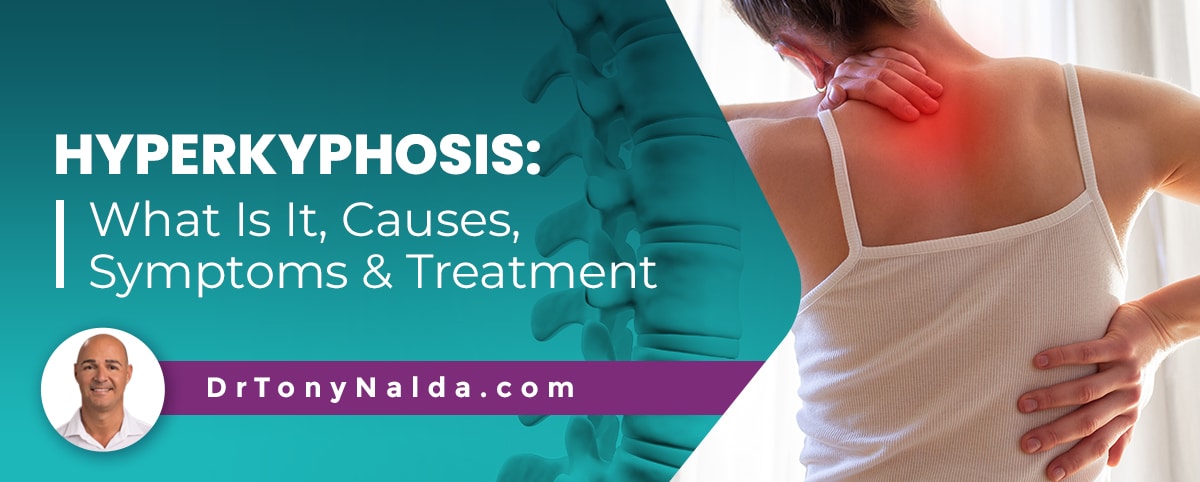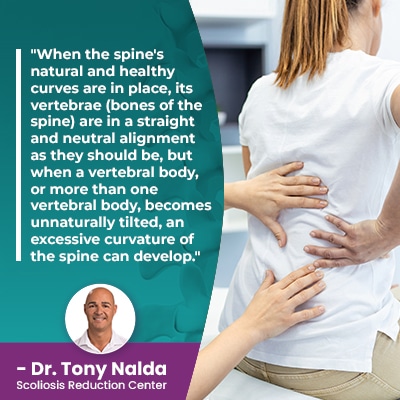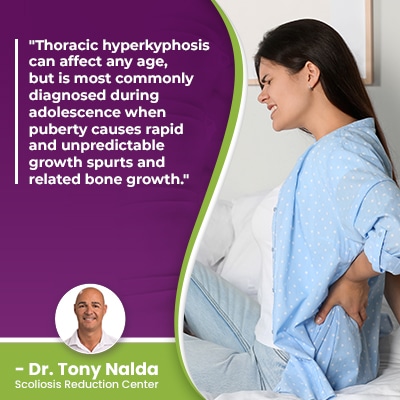Hyperkyphosis: What Is It, Causes, Symptoms & Treatment

The spine's natural and healthy curves are key to maintaining optimal spinal health, strength, and function. Kyphosis and lordosis refer to the two main types of spinal curves: those that bend forwards and those that bend backwards. Continue reading to learn what happens when a person's kyphosis angle increases to the point of becoming an excessive curvature.
There are a number of spinal conditions that cause a loss of its healthy curves and alignment; hyperkyphosis is one of them. Hyperkyphosis is an excessive forward-rounding of the thoracic spine that causes a roundback appearance.
To better understand how hyperkyphosis affects the spine, let's explore the structure of a healthy spine.
Table of Contents
Anatomy of a Healthy Spine
A healthy spine will appear straight if viewed from the front and/or back, and will take on a soft 'S' shape when viewed from the sides; this is because of the spine's natural and healthy curves.
The spine is naturally curved because this makes it stronger, more flexible, and better able to absorb and distribute mechanical stress, somewhat like a coiled spring.
 When the spine's natural and healthy curves are in place, its vertebrae (bones of the spine) are in a straight and neutral alignment as they should be, but when a vertebral body, or more than one vertebral body, becomes unnaturally tilted, an excessive curvature of the spine can develop.
When the spine's natural and healthy curves are in place, its vertebrae (bones of the spine) are in a straight and neutral alignment as they should be, but when a vertebral body, or more than one vertebral body, becomes unnaturally tilted, an excessive curvature of the spine can develop.
The spine has three main sections: cervical spine (neck), thoracic spine (middle/upper back), and the lumbar spine (lower back).
When the spine loses one of its healthy curves, it responds by putting in bad curves; for example, if an unnatural spinal curve develops in the neck, a curve of the opposite type can develop in the lower back in an attempt to counteract the first unnatural curve's uneven forces; these are called compensatory curves.
Spinal vertebrae are separated by intervertebral discs that provide the spine with structure, flexibility, act as the spine's shock absorbers, and prevent friction generated during movement by providing cushioning between adjacent spinal vertebrae.
The intervertebral discs are generally the first structures of the spine to feel the effects of spinal deterioration, and degenerative disc disease can cause a number of spinal issues/conditions to develop, including those that involve the development of a spinal deformity and/or unnatural spinal curves.
The cervical and lumbar sections feature lordotic curves that bend backwards, and the thoracic spine features a kyphotic curve that bends forwards.
Now, there is a healthy range of kyphosis, but if a person's kyphosis angle becomes excessive, this is when problems can occur, and hyperkyphosis is diagnosed.
What is Hyperkyphosis?
A natural and healthy range of thoracic kyphosis would fall between 20 and 45 degrees, but when the spine's thoracic kyphosis exceeds 50 degrees, a number of symptoms can develop.
 Thoracic hyperkyphosis can affect any age, but is most commonly diagnosed during adolescence when puberty causes rapid and unpredictable growth spurts and related bone growth.
Thoracic hyperkyphosis can affect any age, but is most commonly diagnosed during adolescence when puberty causes rapid and unpredictable growth spurts and related bone growth.
Hyperkyphosis can range from mild to severe, depending on the size of the kyphosis angle.
The main symptom of hyperkyphosis is noticeable postural changes such as an excessive forward-rounding of the upper back and shoulders, which is why the condition is commonly referred to as roundback, after the appearance it gives the body.
Additional symptoms of hyperkyphosis can include:
- Back pain (more common in adults for whom the condition is compressive)
- A stiff and rigid spine (reduced spinal flexibility and range of motion that can impact quality of life)
- Tight muscles
- Increased levels of fatigue
- Changes to a person's balance, coordination, and gait
- Difficulty standing and/or sitting for extended periods of time
As is the case with most spinal conditions, symptoms will vary from patient to patient and tend to be shaped by the condition's underlying cause.
Hyperkyphosis Causes
When it comes to common causes of hyperkyphosis, condition type determines this, and there are three main types of hyperkyphosis: postural kyphosis, Scheuermann's disease, and congenital kyphosis.
As each type has its own causation, they also have their own unique treatment needs.
As postural kyphosis is the most prevalent type, let's start there.
Postural Kyphosis
Maintaining alignment of the spine includes practicing healthy posture and postural alignment.
Postural kyphosis is the most common type, and as a nonstructural condition, it is the simplest form to treat.
With postural spinal conditions, a change in position will affect the unnatural spinal curve, whereas with structural spinal conditions, no change in position can alter the unnatural and unhealthy spinal curvature.
Postural kyphosis is caused by chronic poor posture that, over time, alters the body's natural positioning and causes the appearance of slouching.
Most commonly diagnosed in adolescence, a change in body positioning facilitated by physical therapy with a posture training program, and postural alignment training, can achieve postural remodeling so the body's position is improved.
Scheuermann's Disease
Also known as Scheuermann's disease, Scheuermann's kyphosis is a structural condition, meaning it's caused by a structural abnormality within the spine itself, so this is a more complex type to treat than postural kyphosis that's non-structural.
In these types of cases, misshapen vertebrae have disrupted the spine's ability to maintain its natural curves and alignment, and this can cause what's called vertebral wedging that can occur when one or more vertebral bodies are more triangular in shape, than rectangular, as this causes the spine to wedge forward and develop an exaggerated anterior curvature of the thoracic spine.
Spinal curvatures that are excessive don't just affect one section of the spine, but disrupt the entire spine's biomechanics, and this can affect a person's spinal function, strength, health, and overall quality of life.
Treatment for Scheuermann's kyphosis is more complex because it has to, first and foremost, address the spine's structural abnormality, and this is worked towards through a combination of chiropractic care and physical therapy.
Condition-specific techniques and manual adjustments can work towards adjusting the position of the most-tilted vertebrae back into alignment with the rest of the spine, and physical therapy can help increase the spine's surrounding muscle-strength so they can optimally support the spine.
A physical therapist can also help address decreased postural sway, hyperkyphotic posture, flexed posture, postural stiffness, and body positioning through a targeted kyphosis specific exercise program and targeted spine strengthening exercise.
Congenital Kyphosis
Congenital kyphosis is caused by a structural abnormality within the spine that develops in utero while the spine is forming.
When the spine doesn't form properly, functional limitations can become problematic, and an unnatural spinal curve is problematic at any age; this can include vertebrae not forming properly and/or multiple vertebrae becoming fused together as one solid bone, rather than forming into distinct separate vertebral bodies.
Babies born with hyperkyphosis can also have other health issues caused by additional malformations within the body so have to be monitored and assessed closely.
Corrective bracing, when appropriate, and physical therapy can be applied as treatment for congenital kyphosis, but clearly, there are unique challenges associated with treating patients of such a young age.
Conclusion
Hyperkyphosis is diagnosed through combining a physical examination and X-ray imaging to truly see what's happening in and around the spine; I can also tell a lot about a patient's spinal health from their posture and gait.
When the spine's natural and healthy curves are lost, poor physical functional ability of the spine is common, and severe thoracic kyphosis can also affect the lower back's level of lumbar lordosis as the lower back can put in a compensatory curve in an attempt to counteract the unnatural spinal curve above.
If left untreated, severe kyphosis can lead to an osteoporotic spinal deformity, osteoporotic vertebral fractures, future osteoporotic fractures, painful vertebral fractures, vertebral compression fractures, incident spine fractures, incident vertebral fractures, and equal vertebral fractures.
Maintaining healthy kyphotic posture is important when it comes to a healthy thoracic curve.
Risk factors for hyperkyphosis can include chronic poor posture, poor intervertebral disc shape, low bone density, and osteoporotic fractures.
The American Physical Therapy Association can recommend a number of kyphosis-specific exercises and stretches to improve postural alignment, intervertebral disc health, pain management, and bone mineral density to improve functional limitations and limit adverse health outcomes associated with hyperkyphosis.
A corrective exercise strategy can help improve the health of the spine and its surrounding nerves and muscles, improving support and stabilization of the spinal column.
Here at the Scoliosis Reduction Center, I address mild to severe pain caused by hyperkyphosis by first determining its type and causation; then I customize treatment plans around key patient/condition variables.
Hyperkyphotic posture can lead to a number of problems, and depending on whether it is structural or non-structural, treatment can involve
Dr. Tony Nalda
DOCTOR OF CHIROPRACTIC
After receiving an undergraduate degree in psychology and his Doctorate of Chiropractic from Life University, Dr. Nalda settled in Celebration, Florida and proceeded to build one of Central Florida’s most successful chiropractic clinics.
His experience with patients suffering from scoliosis, and the confusion and frustration they faced, led him to seek a specialty in scoliosis care. In 2006 he completed his Intensive Care Certification from CLEAR Institute, a leading scoliosis educational and certification center.
About Dr. Tony Nalda
 Ready to explore scoliosis treatment? Contact Us Now
Ready to explore scoliosis treatment? Contact Us Now





